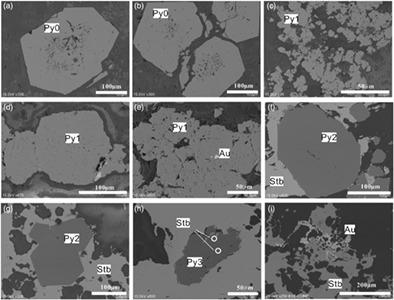当前位置:
X-MOL 学术
›
Resour. Geol.
›
论文详情
Our official English website, www.x-mol.net, welcomes your
feedback! (Note: you will need to create a separate account there.)
Trace elements mineral chemistry of sulfides from the Woxi Au-Sb-W deposit, southern China
Resource Geology ( IF 1.1 ) Pub Date : 2021-09-15 , DOI: 10.1111/rge.12279 Zhekai Zhou 1 , Kotaro Yonezu 1 , Akira Imai 1 , Thomas Tindell 1 , Huan Li 2 , Jillian Aira Gabo‐Ratio 3
Resource Geology ( IF 1.1 ) Pub Date : 2021-09-15 , DOI: 10.1111/rge.12279 Zhekai Zhou 1 , Kotaro Yonezu 1 , Akira Imai 1 , Thomas Tindell 1 , Huan Li 2 , Jillian Aira Gabo‐Ratio 3
Affiliation

|
The Woxi Au-Sb-W deposit is one of the largest polymetallic ore deposits in the Xuefengshan Range, southern China, hosted in low-grade metamorphosed Neoproterozoic volcaniclastic rocks. The orebodies of the deposit are predominantly composed of banded quartz veins, which are strictly controlled by bedding and faults. Petrographic observations and geochemical results are reported on the occurrence of Au and properties of the ore-forming processes for different stages in the deposit. The veins extend vertically up to 2 km without obvious vertical metal zoning. The ore-forming process can be subdivided into four mineralization stages: Pre-ore stage; Early stage (scheelite-quartz stage); Middle stage (pyrite-stibnite-quartz stage); and Late stage (stibnite-quartz sage). Four types of pyrite (Py0, Py1, Py2, and Py3) were identified in the ores and host-rock: Py0 occurs as euhedral grains with voids in the core, ranging in size from 50 to 100 μm and formed mainly in the Pre-ore stage and Early stage; Py1 occurs as subhedral grains. Small grains (around 10 μm) of Py1 form irregularly shaped clusters of variable size ranging from tens to hundreds of μm and mainly formed in the Middle stage; Euhedral-subhedral fine-grained Py2 formed in the Late stage; Minor subhedral fine-grained Py3 was deposited in the Late-stage. Stibnite is widely distributed in the Middle and Late stage ore veins. No systemic difference was recognized in mineralogical features among stibnite formed in different stages. In addition to native gold, the lattice bound Au+1 widely exists in Py1 and Py2 in the deposit, and widespread Py1 is considered as the main Au-bearing mineral with the highest Au contents. Most elements (such as Co, Ni, Cu, As, Sb, Ba, and Pb) are considered to occur as solid solution within the crystal lattice and/or invisible nanoparticles in sulfides minerals. The Co/Ni ratio of most pyrite is lower than 1, suggesting that the metals in the ore-forming fluid are sourced from sedimentary rocks. The coupled behavior between Au and As; Au and Sb suggests that the substitution of As and Sb in pyrite can enhance the incorporation of Au. Variation of trace elements in pyrites of different stages suggests some information on the mineralization processes: Large ion lithophile elements (such as Ba and Pb) are enriched in Py0 indicating that water-rock reaction occurred in the Early stage; Fine-grained Py1 with a heterogeneous distribution of elements suggests fast crystallization of pyrite in the Middle stage.
中文翻译:

华南卧溪金锑钨矿床硫化物微量元素矿物化学
卧溪Au-Sb-W矿床是华南雪峰山山脉最大的多金属矿床之一,赋存于低品位变质新元古代火山碎屑岩中。矿床矿体以带状石英脉为主,受层理和断层的严格控制。报告了矿床不同阶段金的赋存和成矿过程性质的岩石学观察和地球化学结果。矿脉垂直延伸达 2 公里,没有明显的垂直金属分带。成矿过程可细分为四个成矿阶段:前成矿阶段;早期阶段(白钨矿-石英阶段);中间阶段(黄铁矿-辉锑矿-石英阶段);和晚期(辉锑矿-石英鼠尾草)。四种类型的黄铁矿(Py0、Py1、Py2、和Py3)在矿石和围岩中发现:Py0以自面体颗粒的形式出现,在核心具有空隙,尺寸从50到100μm不等,主要形成于预成矿阶段和早期阶段;Py1 以半面体晶粒的形式出现。Py1的小晶粒(约10μm)形成不规则形状的簇,大小从几十到几百μm不等,主要形成于中期;晚期形成的自面体-半面体细粒Py2;次面体细粒Py3沉积在后期。辉锑矿广泛分布于中晚期矿脉中。不同阶段形成的辉锑矿在矿物学特征上未发现系统性差异。除了原生金,晶格结合的金 粒径50~100 μm,主要形成于预矿期和早期;Py1 以半面体晶粒的形式出现。Py1的小晶粒(约10μm)形成不规则形状的簇,大小从几十到几百μm不等,主要形成于中期;晚期形成的自面体-半面体细粒Py2;次面体细粒Py3沉积在后期。辉锑矿广泛分布于中晚期矿脉中。不同阶段形成的辉锑矿在矿物学特征上未发现系统性差异。除了原生金,晶格结合的金 粒径50~100 μm,主要形成于预矿期和早期;Py1 以半面体晶粒的形式出现。Py1的小晶粒(约10μm)形成不规则形状的簇,大小从几十到几百μm不等,主要形成于中期;晚期形成的自面体-半面体细粒Py2;次面体细粒Py3沉积在后期。辉锑矿广泛分布于中晚期矿脉中。不同阶段形成的辉锑矿在矿物学特征上未发现系统性差异。除了原生金,晶格结合的金 Py1的小晶粒(约10μm)形成不规则形状的簇,大小从几十到几百μm不等,主要形成于中期;晚期形成的自面体-半面体细粒Py2;次面体细粒Py3沉积在后期。辉锑矿广泛分布于中晚期矿脉中。不同阶段形成的辉锑矿在矿物学特征上未发现系统性差异。除了原生金,晶格结合的金 Py1的小晶粒(约10μm)形成不规则形状的簇,大小从几十到几百μm不等,主要形成于中期;晚期形成的自面体-半面体细粒Py2;次面体细粒Py3沉积在后期。辉锑矿广泛分布于中晚期矿脉中。不同阶段形成的辉锑矿在矿物学特征上未发现系统性差异。除了原生金,晶格结合的金+1广泛存在于矿床Py1和Py2中,Py1被认为是Au含量最高的主要含金矿物。大多数元素(如 Co、Ni、Cu、As、Sb、Ba 和 Pb)被认为以固溶体形式存在于晶格和/或硫化物矿物中的不可见纳米颗粒中。大多数黄铁矿的Co/Ni比小于1,表明成矿流体中的金属来源于沉积岩。Au和As之间的耦合行为;Au和Sb表明黄铁矿中As和Sb的替代可以增强Au的掺入。不同阶段黄铁矿中微量元素的变化表明了成矿过程的一些信息:Py0中富集大离子亲石元素(如Ba、Pb),表明水-岩反应发生在早期;
更新日期:2021-09-15
中文翻译:

华南卧溪金锑钨矿床硫化物微量元素矿物化学
卧溪Au-Sb-W矿床是华南雪峰山山脉最大的多金属矿床之一,赋存于低品位变质新元古代火山碎屑岩中。矿床矿体以带状石英脉为主,受层理和断层的严格控制。报告了矿床不同阶段金的赋存和成矿过程性质的岩石学观察和地球化学结果。矿脉垂直延伸达 2 公里,没有明显的垂直金属分带。成矿过程可细分为四个成矿阶段:前成矿阶段;早期阶段(白钨矿-石英阶段);中间阶段(黄铁矿-辉锑矿-石英阶段);和晚期(辉锑矿-石英鼠尾草)。四种类型的黄铁矿(Py0、Py1、Py2、和Py3)在矿石和围岩中发现:Py0以自面体颗粒的形式出现,在核心具有空隙,尺寸从50到100μm不等,主要形成于预成矿阶段和早期阶段;Py1 以半面体晶粒的形式出现。Py1的小晶粒(约10μm)形成不规则形状的簇,大小从几十到几百μm不等,主要形成于中期;晚期形成的自面体-半面体细粒Py2;次面体细粒Py3沉积在后期。辉锑矿广泛分布于中晚期矿脉中。不同阶段形成的辉锑矿在矿物学特征上未发现系统性差异。除了原生金,晶格结合的金 粒径50~100 μm,主要形成于预矿期和早期;Py1 以半面体晶粒的形式出现。Py1的小晶粒(约10μm)形成不规则形状的簇,大小从几十到几百μm不等,主要形成于中期;晚期形成的自面体-半面体细粒Py2;次面体细粒Py3沉积在后期。辉锑矿广泛分布于中晚期矿脉中。不同阶段形成的辉锑矿在矿物学特征上未发现系统性差异。除了原生金,晶格结合的金 粒径50~100 μm,主要形成于预矿期和早期;Py1 以半面体晶粒的形式出现。Py1的小晶粒(约10μm)形成不规则形状的簇,大小从几十到几百μm不等,主要形成于中期;晚期形成的自面体-半面体细粒Py2;次面体细粒Py3沉积在后期。辉锑矿广泛分布于中晚期矿脉中。不同阶段形成的辉锑矿在矿物学特征上未发现系统性差异。除了原生金,晶格结合的金 Py1的小晶粒(约10μm)形成不规则形状的簇,大小从几十到几百μm不等,主要形成于中期;晚期形成的自面体-半面体细粒Py2;次面体细粒Py3沉积在后期。辉锑矿广泛分布于中晚期矿脉中。不同阶段形成的辉锑矿在矿物学特征上未发现系统性差异。除了原生金,晶格结合的金 Py1的小晶粒(约10μm)形成不规则形状的簇,大小从几十到几百μm不等,主要形成于中期;晚期形成的自面体-半面体细粒Py2;次面体细粒Py3沉积在后期。辉锑矿广泛分布于中晚期矿脉中。不同阶段形成的辉锑矿在矿物学特征上未发现系统性差异。除了原生金,晶格结合的金+1广泛存在于矿床Py1和Py2中,Py1被认为是Au含量最高的主要含金矿物。大多数元素(如 Co、Ni、Cu、As、Sb、Ba 和 Pb)被认为以固溶体形式存在于晶格和/或硫化物矿物中的不可见纳米颗粒中。大多数黄铁矿的Co/Ni比小于1,表明成矿流体中的金属来源于沉积岩。Au和As之间的耦合行为;Au和Sb表明黄铁矿中As和Sb的替代可以增强Au的掺入。不同阶段黄铁矿中微量元素的变化表明了成矿过程的一些信息:Py0中富集大离子亲石元素(如Ba、Pb),表明水-岩反应发生在早期;











































 京公网安备 11010802027423号
京公网安备 11010802027423号